Literature Review: Biochar's Impact on Plant Growth and Soil Pathogens
VerifiedAdded on 2020/05/04
|19
|5360
|66
Literature Review
AI Summary
This literature review delves into the multifaceted role of biochar in enhancing plant growth, improving soil properties, and suppressing soil pathogens. The study explores the use of biochar as a soil amendment, highlighting its positive impacts on nutrient and water retention, carbon sequestration, and reduction of greenhouse gas emissions. The review emphasizes biochar's potential in controlling soil-borne diseases, particularly crown rot disease in barley, and discusses the mechanisms through which biochar achieves these beneficial effects, including inducing systemic resistance and modifying soil quality. It further examines the application of biochar in agriculture, its benefits for barley cultivation, and its potential in mitigating climate change. The paper also addresses the challenges associated with biochar use, such as the need for standardized production methods and awareness of biochar properties, while emphasizing its promise for sustainable agricultural practices. The literature review extensively covers the introduction, benefits, methods of inoculation, possible explanations, and references, providing a comprehensive overview of biochar's impact on plant health and environmental sustainability.
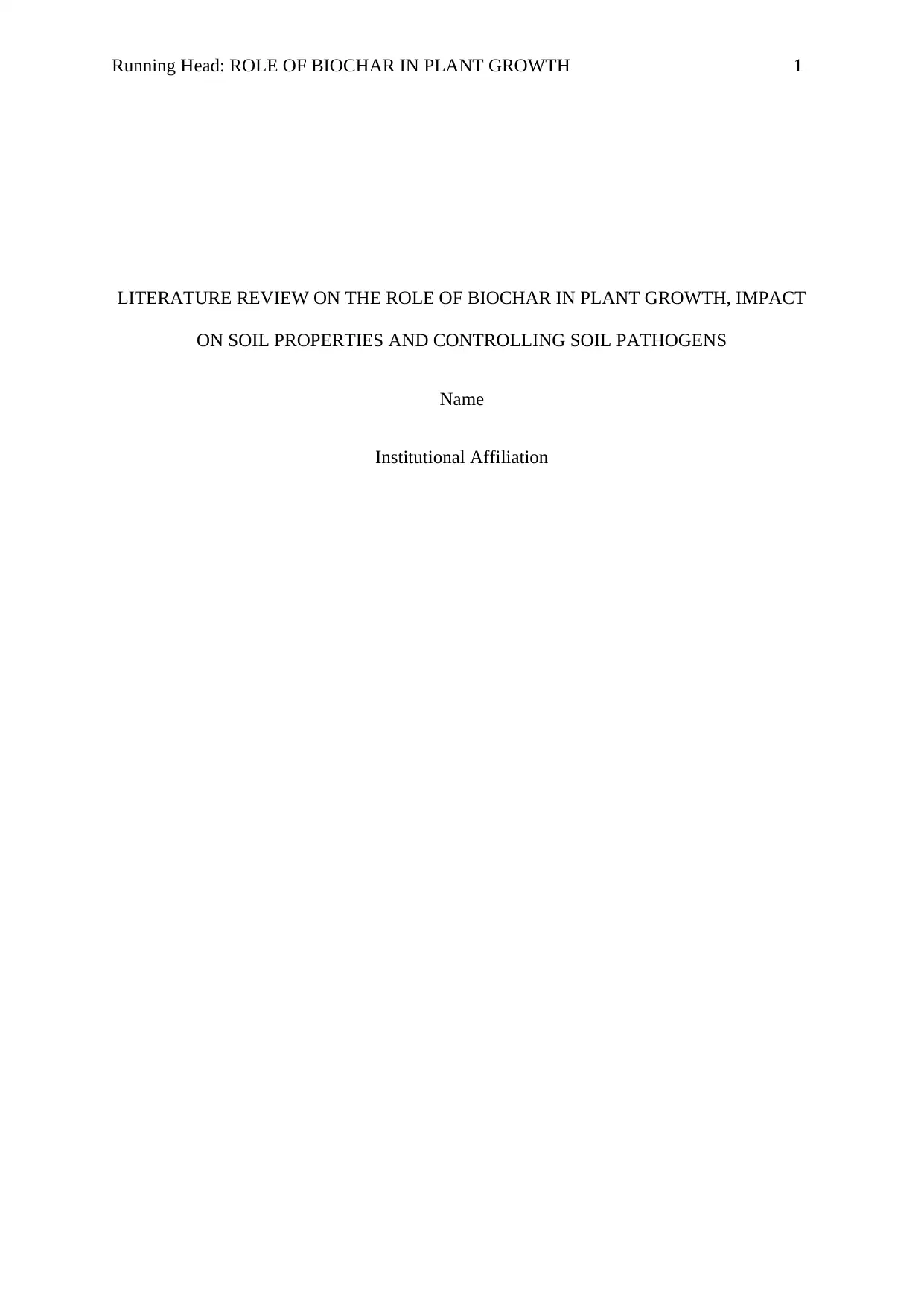
Running Head: ROLE OF BIOCHAR IN PLANT GROWTH 1
LITERATURE REVIEW ON THE ROLE OF BIOCHAR IN PLANT GROWTH, IMPACT
ON SOIL PROPERTIES AND CONTROLLING SOIL PATHOGENS
Name
Institutional Affiliation
LITERATURE REVIEW ON THE ROLE OF BIOCHAR IN PLANT GROWTH, IMPACT
ON SOIL PROPERTIES AND CONTROLLING SOIL PATHOGENS
Name
Institutional Affiliation
Paraphrase This Document
Need a fresh take? Get an instant paraphrase of this document with our AI Paraphraser
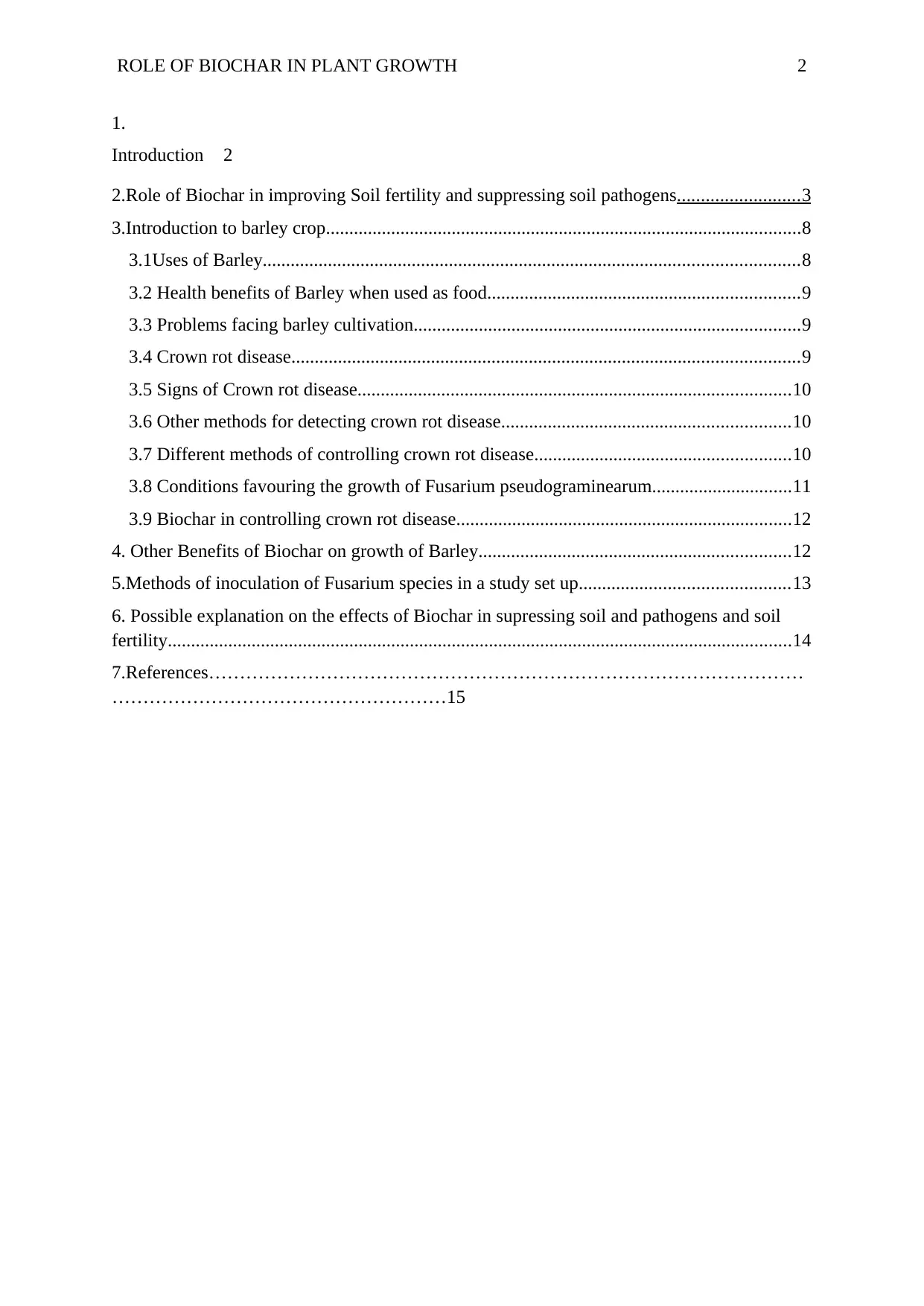
ROLE OF BIOCHAR IN PLANT GROWTH 2
1.
Introduction 2
2.Role of Biochar in improving Soil fertility and suppressing soil pathogens..........................3
3.Introduction to barley crop......................................................................................................8
3.1Uses of Barley...................................................................................................................8
3.2 Health benefits of Barley when used as food...................................................................9
3.3 Problems facing barley cultivation...................................................................................9
3.4 Crown rot disease.............................................................................................................9
3.5 Signs of Crown rot disease.............................................................................................10
3.6 Other methods for detecting crown rot disease..............................................................10
3.7 Different methods of controlling crown rot disease.......................................................10
3.8 Conditions favouring the growth of Fusarium pseudograminearum..............................11
3.9 Biochar in controlling crown rot disease........................................................................12
4. Other Benefits of Biochar on growth of Barley...................................................................12
5.Methods of inoculation of Fusarium species in a study set up.............................................13
6. Possible explanation on the effects of Biochar in supressing soil and pathogens and soil
fertility......................................................................................................................................14
7.References……………………………………………………………………………………
………………………………………………15
1.
Introduction 2
2.Role of Biochar in improving Soil fertility and suppressing soil pathogens..........................3
3.Introduction to barley crop......................................................................................................8
3.1Uses of Barley...................................................................................................................8
3.2 Health benefits of Barley when used as food...................................................................9
3.3 Problems facing barley cultivation...................................................................................9
3.4 Crown rot disease.............................................................................................................9
3.5 Signs of Crown rot disease.............................................................................................10
3.6 Other methods for detecting crown rot disease..............................................................10
3.7 Different methods of controlling crown rot disease.......................................................10
3.8 Conditions favouring the growth of Fusarium pseudograminearum..............................11
3.9 Biochar in controlling crown rot disease........................................................................12
4. Other Benefits of Biochar on growth of Barley...................................................................12
5.Methods of inoculation of Fusarium species in a study set up.............................................13
6. Possible explanation on the effects of Biochar in supressing soil and pathogens and soil
fertility......................................................................................................................................14
7.References……………………………………………………………………………………
………………………………………………15
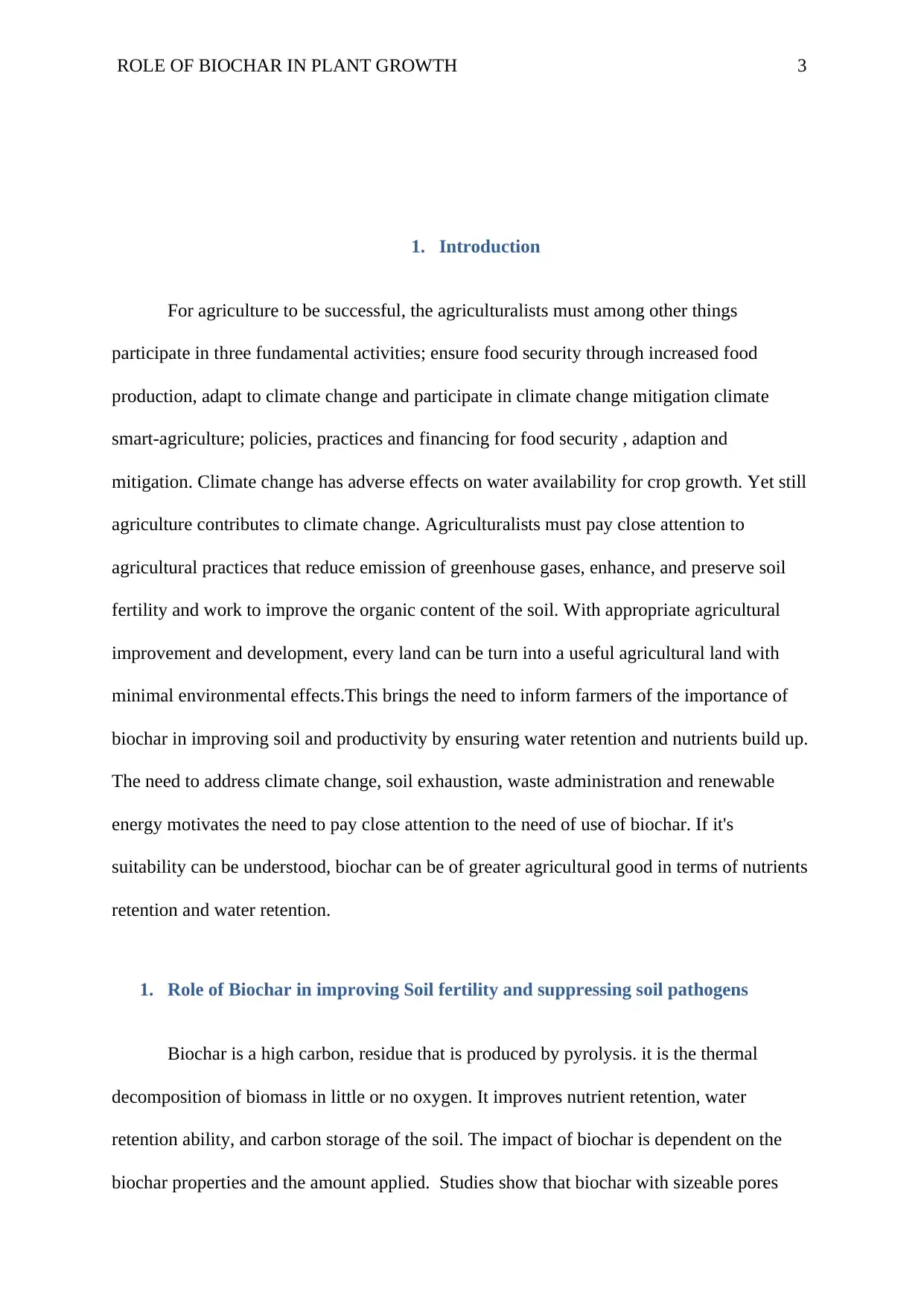
ROLE OF BIOCHAR IN PLANT GROWTH 3
1. Introduction
For agriculture to be successful, the agriculturalists must among other things
participate in three fundamental activities; ensure food security through increased food
production, adapt to climate change and participate in climate change mitigation climate
smart-agriculture; policies, practices and financing for food security , adaption and
mitigation. Climate change has adverse effects on water availability for crop growth. Yet still
agriculture contributes to climate change. Agriculturalists must pay close attention to
agricultural practices that reduce emission of greenhouse gases, enhance, and preserve soil
fertility and work to improve the organic content of the soil. With appropriate agricultural
improvement and development, every land can be turn into a useful agricultural land with
minimal environmental effects.This brings the need to inform farmers of the importance of
biochar in improving soil and productivity by ensuring water retention and nutrients build up.
The need to address climate change, soil exhaustion, waste administration and renewable
energy motivates the need to pay close attention to the need of use of biochar. If it's
suitability can be understood, biochar can be of greater agricultural good in terms of nutrients
retention and water retention.
1. Role of Biochar in improving Soil fertility and suppressing soil pathogens
Biochar is a high carbon, residue that is produced by pyrolysis. it is the thermal
decomposition of biomass in little or no oxygen. It improves nutrient retention, water
retention ability, and carbon storage of the soil. The impact of biochar is dependent on the
biochar properties and the amount applied. Studies show that biochar with sizeable pores
1. Introduction
For agriculture to be successful, the agriculturalists must among other things
participate in three fundamental activities; ensure food security through increased food
production, adapt to climate change and participate in climate change mitigation climate
smart-agriculture; policies, practices and financing for food security , adaption and
mitigation. Climate change has adverse effects on water availability for crop growth. Yet still
agriculture contributes to climate change. Agriculturalists must pay close attention to
agricultural practices that reduce emission of greenhouse gases, enhance, and preserve soil
fertility and work to improve the organic content of the soil. With appropriate agricultural
improvement and development, every land can be turn into a useful agricultural land with
minimal environmental effects.This brings the need to inform farmers of the importance of
biochar in improving soil and productivity by ensuring water retention and nutrients build up.
The need to address climate change, soil exhaustion, waste administration and renewable
energy motivates the need to pay close attention to the need of use of biochar. If it's
suitability can be understood, biochar can be of greater agricultural good in terms of nutrients
retention and water retention.
1. Role of Biochar in improving Soil fertility and suppressing soil pathogens
Biochar is a high carbon, residue that is produced by pyrolysis. it is the thermal
decomposition of biomass in little or no oxygen. It improves nutrient retention, water
retention ability, and carbon storage of the soil. The impact of biochar is dependent on the
biochar properties and the amount applied. Studies show that biochar with sizeable pores
⊘ This is a preview!⊘
Do you want full access?
Subscribe today to unlock all pages.

Trusted by 1+ million students worldwide
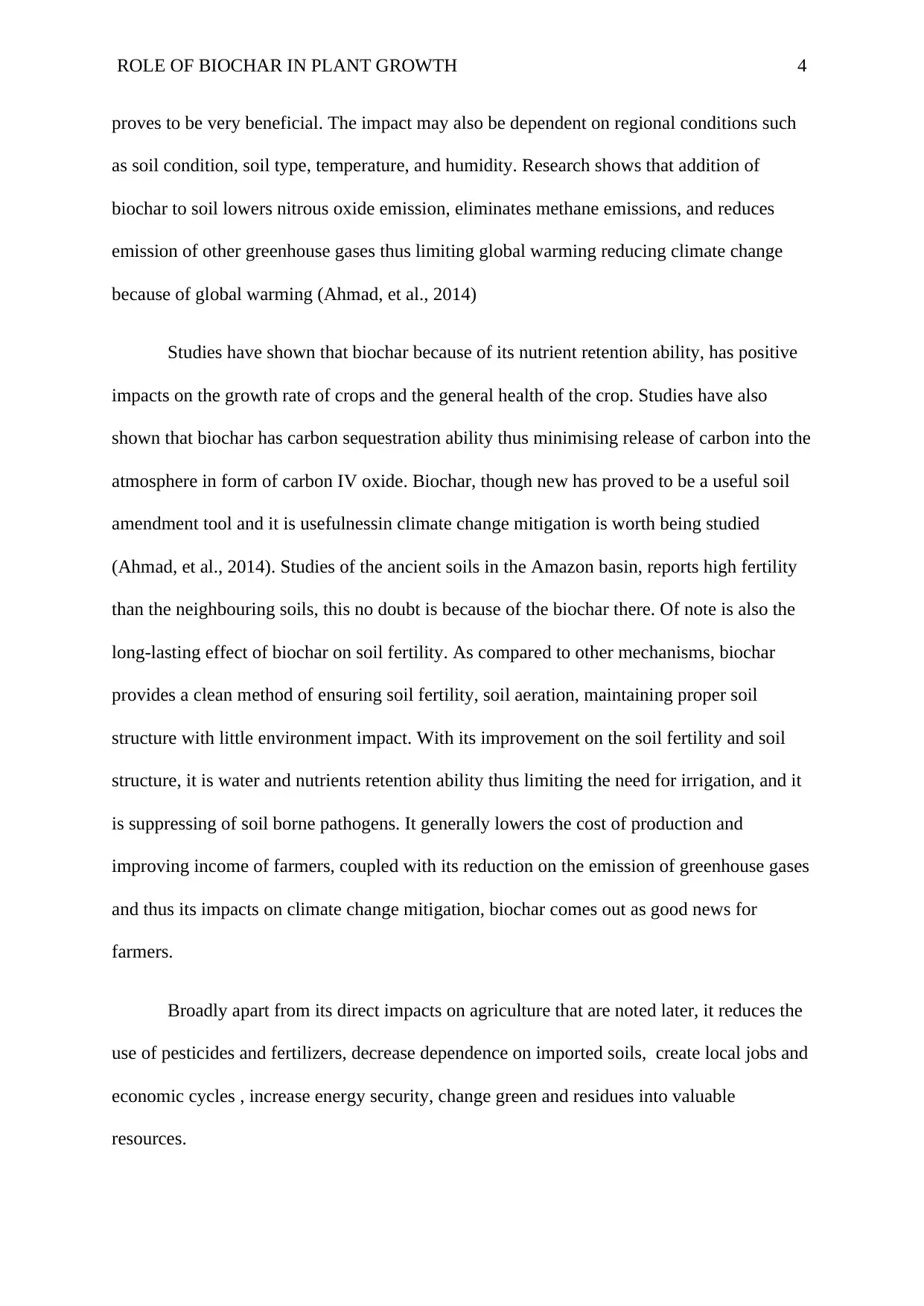
ROLE OF BIOCHAR IN PLANT GROWTH 4
proves to be very beneficial. The impact may also be dependent on regional conditions such
as soil condition, soil type, temperature, and humidity. Research shows that addition of
biochar to soil lowers nitrous oxide emission, eliminates methane emissions, and reduces
emission of other greenhouse gases thus limiting global warming reducing climate change
because of global warming (Ahmad, et al., 2014)
Studies have shown that biochar because of its nutrient retention ability, has positive
impacts on the growth rate of crops and the general health of the crop. Studies have also
shown that biochar has carbon sequestration ability thus minimising release of carbon into the
atmosphere in form of carbon IV oxide. Biochar, though new has proved to be a useful soil
amendment tool and it is usefulnessin climate change mitigation is worth being studied
(Ahmad, et al., 2014). Studies of the ancient soils in the Amazon basin, reports high fertility
than the neighbouring soils, this no doubt is because of the biochar there. Of note is also the
long-lasting effect of biochar on soil fertility. As compared to other mechanisms, biochar
provides a clean method of ensuring soil fertility, soil aeration, maintaining proper soil
structure with little environment impact. With its improvement on the soil fertility and soil
structure, it is water and nutrients retention ability thus limiting the need for irrigation, and it
is suppressing of soil borne pathogens. It generally lowers the cost of production and
improving income of farmers, coupled with its reduction on the emission of greenhouse gases
and thus its impacts on climate change mitigation, biochar comes out as good news for
farmers.
Broadly apart from its direct impacts on agriculture that are noted later, it reduces the
use of pesticides and fertilizers, decrease dependence on imported soils, create local jobs and
economic cycles , increase energy security, change green and residues into valuable
resources.
proves to be very beneficial. The impact may also be dependent on regional conditions such
as soil condition, soil type, temperature, and humidity. Research shows that addition of
biochar to soil lowers nitrous oxide emission, eliminates methane emissions, and reduces
emission of other greenhouse gases thus limiting global warming reducing climate change
because of global warming (Ahmad, et al., 2014)
Studies have shown that biochar because of its nutrient retention ability, has positive
impacts on the growth rate of crops and the general health of the crop. Studies have also
shown that biochar has carbon sequestration ability thus minimising release of carbon into the
atmosphere in form of carbon IV oxide. Biochar, though new has proved to be a useful soil
amendment tool and it is usefulnessin climate change mitigation is worth being studied
(Ahmad, et al., 2014). Studies of the ancient soils in the Amazon basin, reports high fertility
than the neighbouring soils, this no doubt is because of the biochar there. Of note is also the
long-lasting effect of biochar on soil fertility. As compared to other mechanisms, biochar
provides a clean method of ensuring soil fertility, soil aeration, maintaining proper soil
structure with little environment impact. With its improvement on the soil fertility and soil
structure, it is water and nutrients retention ability thus limiting the need for irrigation, and it
is suppressing of soil borne pathogens. It generally lowers the cost of production and
improving income of farmers, coupled with its reduction on the emission of greenhouse gases
and thus its impacts on climate change mitigation, biochar comes out as good news for
farmers.
Broadly apart from its direct impacts on agriculture that are noted later, it reduces the
use of pesticides and fertilizers, decrease dependence on imported soils, create local jobs and
economic cycles , increase energy security, change green and residues into valuable
resources.
Paraphrase This Document
Need a fresh take? Get an instant paraphrase of this document with our AI Paraphraser
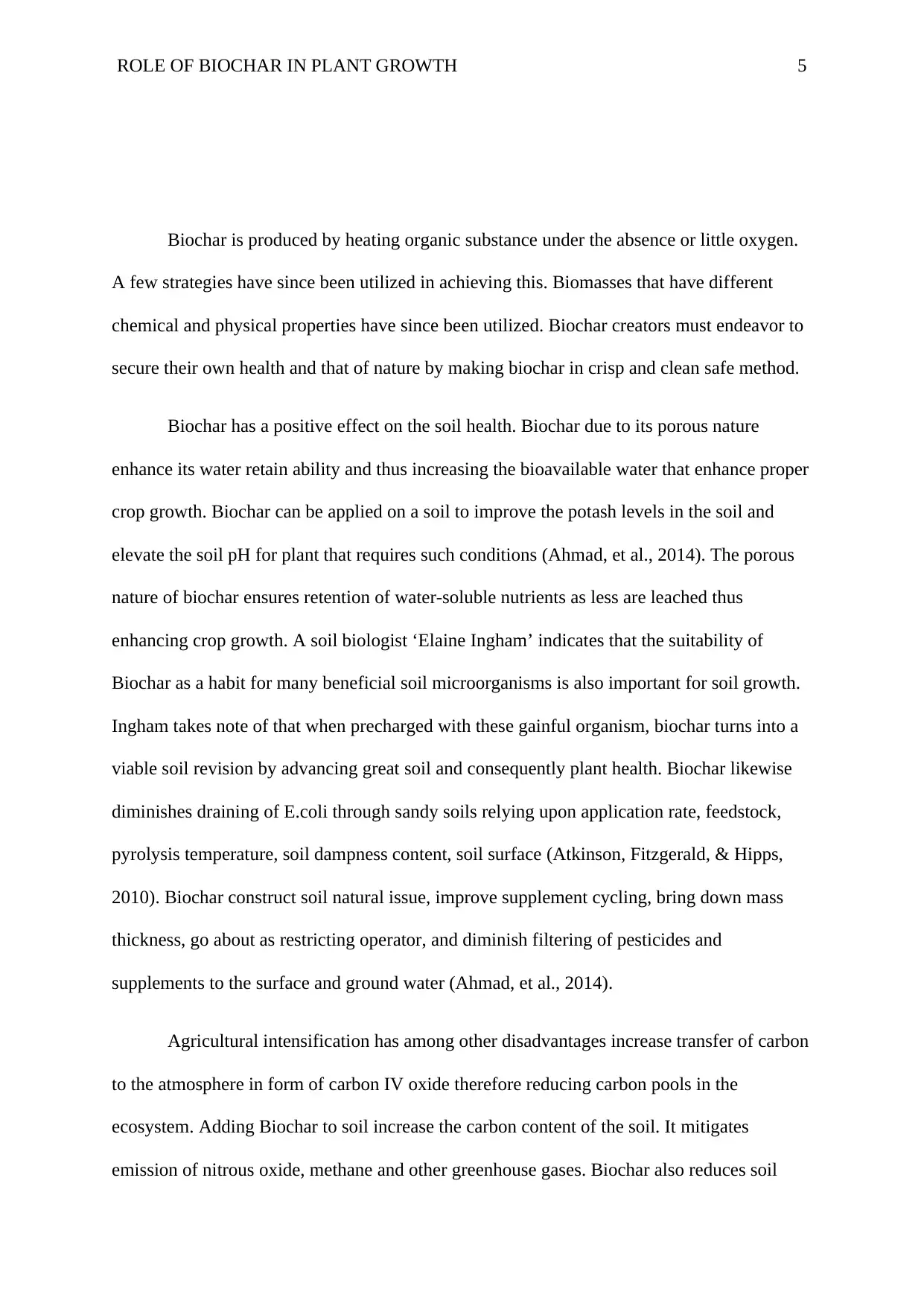
ROLE OF BIOCHAR IN PLANT GROWTH 5
Biochar is produced by heating organic substance under the absence or little oxygen.
A few strategies have since been utilized in achieving this. Biomasses that have different
chemical and physical properties have since been utilized. Biochar creators must endeavor to
secure their own health and that of nature by making biochar in crisp and clean safe method.
Biochar has a positive effect on the soil health. Biochar due to its porous nature
enhance its water retain ability and thus increasing the bioavailable water that enhance proper
crop growth. Biochar can be applied on a soil to improve the potash levels in the soil and
elevate the soil pH for plant that requires such conditions (Ahmad, et al., 2014). The porous
nature of biochar ensures retention of water-soluble nutrients as less are leached thus
enhancing crop growth. A soil biologist ‘Elaine Ingham’ indicates that the suitability of
Biochar as a habit for many beneficial soil microorganisms is also important for soil growth.
Ingham takes note of that when precharged with these gainful organism, biochar turns into a
viable soil revision by advancing great soil and consequently plant health. Biochar likewise
diminishes draining of E.coli through sandy soils relying upon application rate, feedstock,
pyrolysis temperature, soil dampness content, soil surface (Atkinson, Fitzgerald, & Hipps,
2010). Biochar construct soil natural issue, improve supplement cycling, bring down mass
thickness, go about as restricting operator, and diminish filtering of pesticides and
supplements to the surface and ground water (Ahmad, et al., 2014).
Agricultural intensification has among other disadvantages increase transfer of carbon
to the atmosphere in form of carbon IV oxide therefore reducing carbon pools in the
ecosystem. Adding Biochar to soil increase the carbon content of the soil. It mitigates
emission of nitrous oxide, methane and other greenhouse gases. Biochar also reduces soil
Biochar is produced by heating organic substance under the absence or little oxygen.
A few strategies have since been utilized in achieving this. Biomasses that have different
chemical and physical properties have since been utilized. Biochar creators must endeavor to
secure their own health and that of nature by making biochar in crisp and clean safe method.
Biochar has a positive effect on the soil health. Biochar due to its porous nature
enhance its water retain ability and thus increasing the bioavailable water that enhance proper
crop growth. Biochar can be applied on a soil to improve the potash levels in the soil and
elevate the soil pH for plant that requires such conditions (Ahmad, et al., 2014). The porous
nature of biochar ensures retention of water-soluble nutrients as less are leached thus
enhancing crop growth. A soil biologist ‘Elaine Ingham’ indicates that the suitability of
Biochar as a habit for many beneficial soil microorganisms is also important for soil growth.
Ingham takes note of that when precharged with these gainful organism, biochar turns into a
viable soil revision by advancing great soil and consequently plant health. Biochar likewise
diminishes draining of E.coli through sandy soils relying upon application rate, feedstock,
pyrolysis temperature, soil dampness content, soil surface (Atkinson, Fitzgerald, & Hipps,
2010). Biochar construct soil natural issue, improve supplement cycling, bring down mass
thickness, go about as restricting operator, and diminish filtering of pesticides and
supplements to the surface and ground water (Ahmad, et al., 2014).
Agricultural intensification has among other disadvantages increase transfer of carbon
to the atmosphere in form of carbon IV oxide therefore reducing carbon pools in the
ecosystem. Adding Biochar to soil increase the carbon content of the soil. It mitigates
emission of nitrous oxide, methane and other greenhouse gases. Biochar also reduces soil
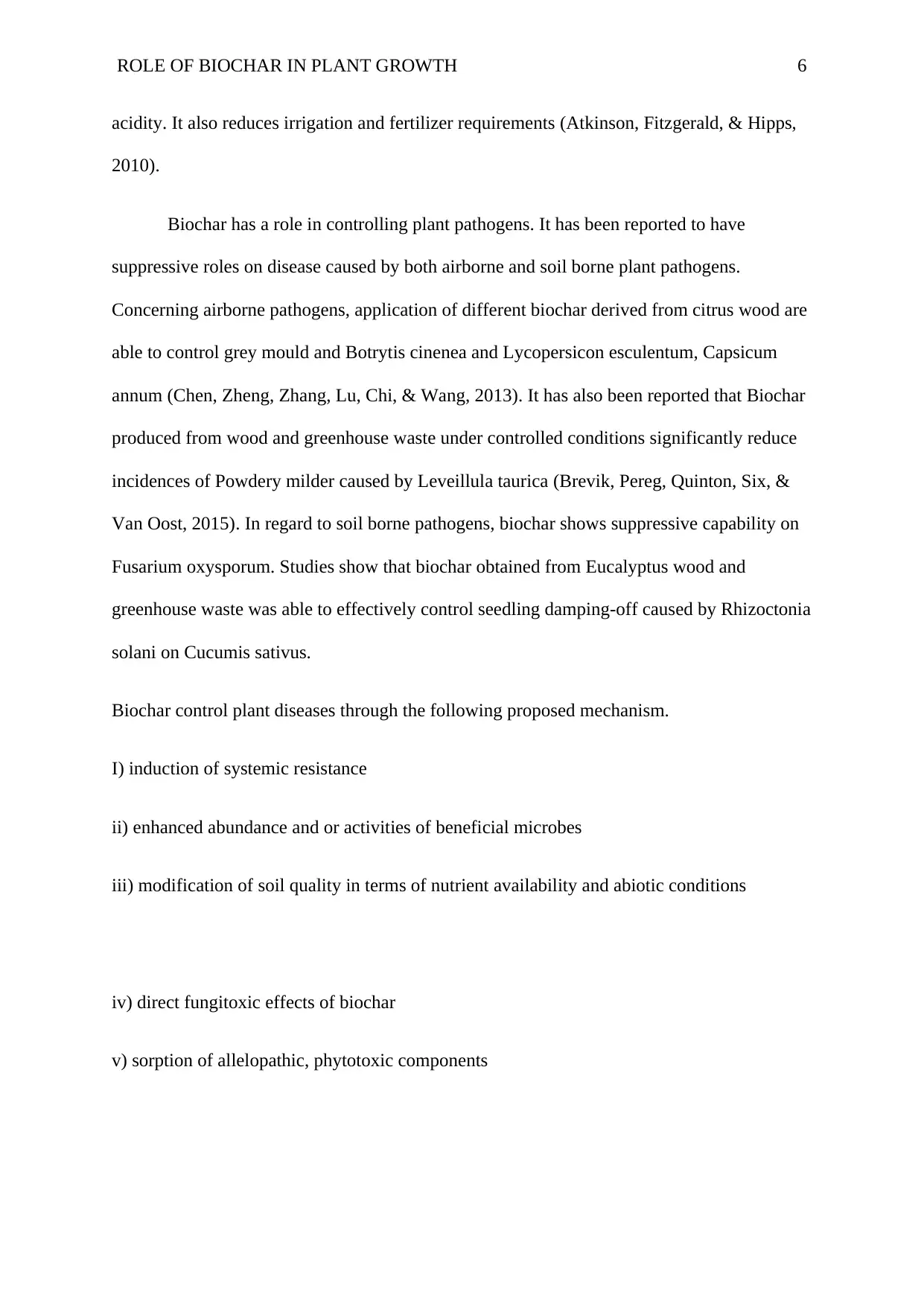
ROLE OF BIOCHAR IN PLANT GROWTH 6
acidity. It also reduces irrigation and fertilizer requirements (Atkinson, Fitzgerald, & Hipps,
2010).
Biochar has a role in controlling plant pathogens. It has been reported to have
suppressive roles on disease caused by both airborne and soil borne plant pathogens.
Concerning airborne pathogens, application of different biochar derived from citrus wood are
able to control grey mould and Botrytis cinenea and Lycopersicon esculentum, Capsicum
annum (Chen, Zheng, Zhang, Lu, Chi, & Wang, 2013). It has also been reported that Biochar
produced from wood and greenhouse waste under controlled conditions significantly reduce
incidences of Powdery milder caused by Leveillula taurica (Brevik, Pereg, Quinton, Six, &
Van Oost, 2015). In regard to soil borne pathogens, biochar shows suppressive capability on
Fusarium oxysporum. Studies show that biochar obtained from Eucalyptus wood and
greenhouse waste was able to effectively control seedling damping-off caused by Rhizoctonia
solani on Cucumis sativus.
Biochar control plant diseases through the following proposed mechanism.
I) induction of systemic resistance
ii) enhanced abundance and or activities of beneficial microbes
iii) modification of soil quality in terms of nutrient availability and abiotic conditions
iv) direct fungitoxic effects of biochar
v) sorption of allelopathic, phytotoxic components
acidity. It also reduces irrigation and fertilizer requirements (Atkinson, Fitzgerald, & Hipps,
2010).
Biochar has a role in controlling plant pathogens. It has been reported to have
suppressive roles on disease caused by both airborne and soil borne plant pathogens.
Concerning airborne pathogens, application of different biochar derived from citrus wood are
able to control grey mould and Botrytis cinenea and Lycopersicon esculentum, Capsicum
annum (Chen, Zheng, Zhang, Lu, Chi, & Wang, 2013). It has also been reported that Biochar
produced from wood and greenhouse waste under controlled conditions significantly reduce
incidences of Powdery milder caused by Leveillula taurica (Brevik, Pereg, Quinton, Six, &
Van Oost, 2015). In regard to soil borne pathogens, biochar shows suppressive capability on
Fusarium oxysporum. Studies show that biochar obtained from Eucalyptus wood and
greenhouse waste was able to effectively control seedling damping-off caused by Rhizoctonia
solani on Cucumis sativus.
Biochar control plant diseases through the following proposed mechanism.
I) induction of systemic resistance
ii) enhanced abundance and or activities of beneficial microbes
iii) modification of soil quality in terms of nutrient availability and abiotic conditions
iv) direct fungitoxic effects of biochar
v) sorption of allelopathic, phytotoxic components
⊘ This is a preview!⊘
Do you want full access?
Subscribe today to unlock all pages.

Trusted by 1+ million students worldwide
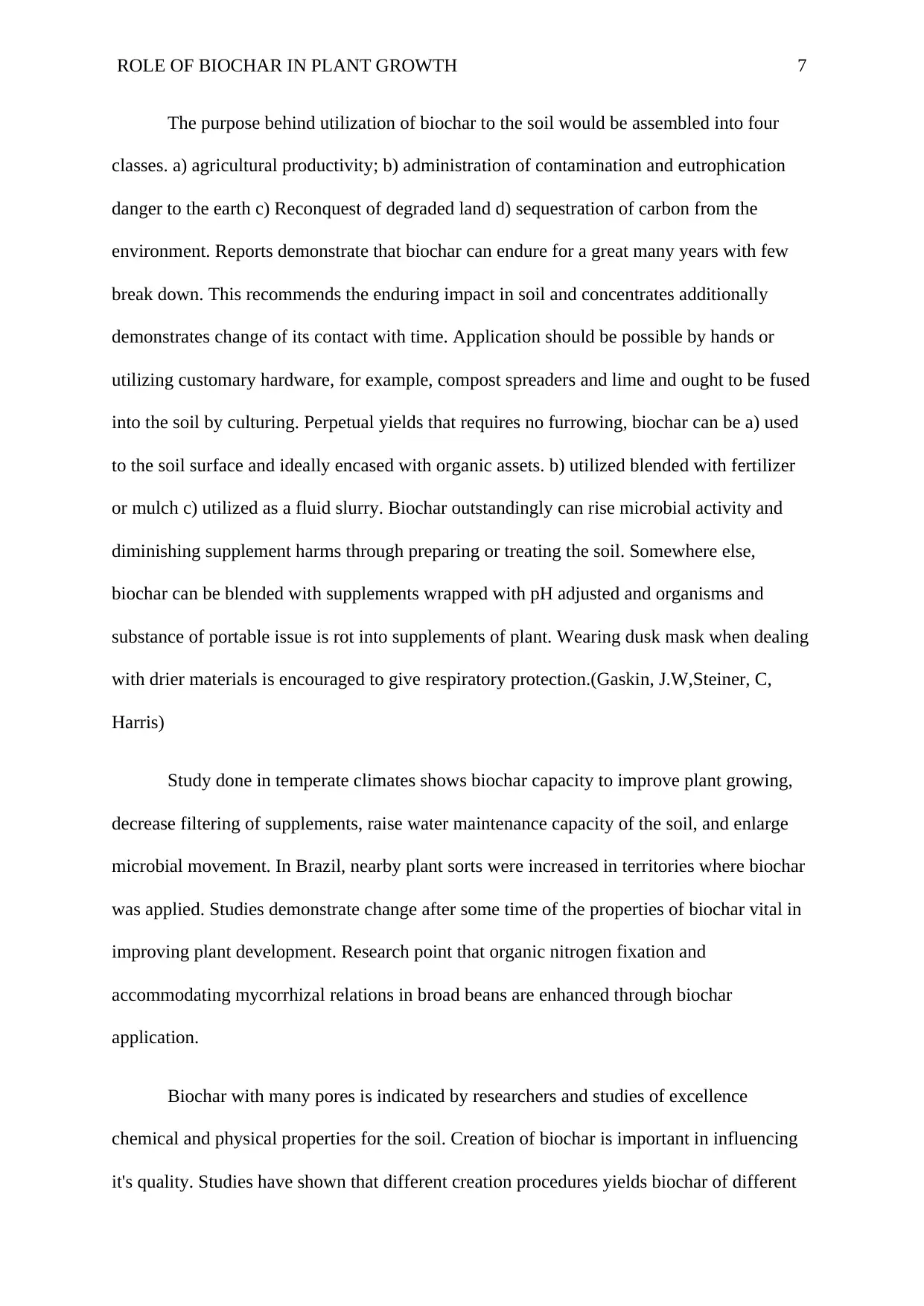
ROLE OF BIOCHAR IN PLANT GROWTH 7
The purpose behind utilization of biochar to the soil would be assembled into four
classes. a) agricultural productivity; b) administration of contamination and eutrophication
danger to the earth c) Reconquest of degraded land d) sequestration of carbon from the
environment. Reports demonstrate that biochar can endure for a great many years with few
break down. This recommends the enduring impact in soil and concentrates additionally
demonstrates change of its contact with time. Application should be possible by hands or
utilizing customary hardware, for example, compost spreaders and lime and ought to be fused
into the soil by culturing. Perpetual yields that requires no furrowing, biochar can be a) used
to the soil surface and ideally encased with organic assets. b) utilized blended with fertilizer
or mulch c) utilized as a fluid slurry. Biochar outstandingly can rise microbial activity and
diminishing supplement harms through preparing or treating the soil. Somewhere else,
biochar can be blended with supplements wrapped with pH adjusted and organisms and
substance of portable issue is rot into supplements of plant. Wearing dusk mask when dealing
with drier materials is encouraged to give respiratory protection.(Gaskin, J.W,Steiner, C,
Harris)
Study done in temperate climates shows biochar capacity to improve plant growing,
decrease filtering of supplements, raise water maintenance capacity of the soil, and enlarge
microbial movement. In Brazil, nearby plant sorts were increased in territories where biochar
was applied. Studies demonstrate change after some time of the properties of biochar vital in
improving plant development. Research point that organic nitrogen fixation and
accommodating mycorrhizal relations in broad beans are enhanced through biochar
application.
Biochar with many pores is indicated by researchers and studies of excellence
chemical and physical properties for the soil. Creation of biochar is important in influencing
it's quality. Studies have shown that different creation procedures yields biochar of different
The purpose behind utilization of biochar to the soil would be assembled into four
classes. a) agricultural productivity; b) administration of contamination and eutrophication
danger to the earth c) Reconquest of degraded land d) sequestration of carbon from the
environment. Reports demonstrate that biochar can endure for a great many years with few
break down. This recommends the enduring impact in soil and concentrates additionally
demonstrates change of its contact with time. Application should be possible by hands or
utilizing customary hardware, for example, compost spreaders and lime and ought to be fused
into the soil by culturing. Perpetual yields that requires no furrowing, biochar can be a) used
to the soil surface and ideally encased with organic assets. b) utilized blended with fertilizer
or mulch c) utilized as a fluid slurry. Biochar outstandingly can rise microbial activity and
diminishing supplement harms through preparing or treating the soil. Somewhere else,
biochar can be blended with supplements wrapped with pH adjusted and organisms and
substance of portable issue is rot into supplements of plant. Wearing dusk mask when dealing
with drier materials is encouraged to give respiratory protection.(Gaskin, J.W,Steiner, C,
Harris)
Study done in temperate climates shows biochar capacity to improve plant growing,
decrease filtering of supplements, raise water maintenance capacity of the soil, and enlarge
microbial movement. In Brazil, nearby plant sorts were increased in territories where biochar
was applied. Studies demonstrate change after some time of the properties of biochar vital in
improving plant development. Research point that organic nitrogen fixation and
accommodating mycorrhizal relations in broad beans are enhanced through biochar
application.
Biochar with many pores is indicated by researchers and studies of excellence
chemical and physical properties for the soil. Creation of biochar is important in influencing
it's quality. Studies have shown that different creation procedures yields biochar of different
Paraphrase This Document
Need a fresh take? Get an instant paraphrase of this document with our AI Paraphraser
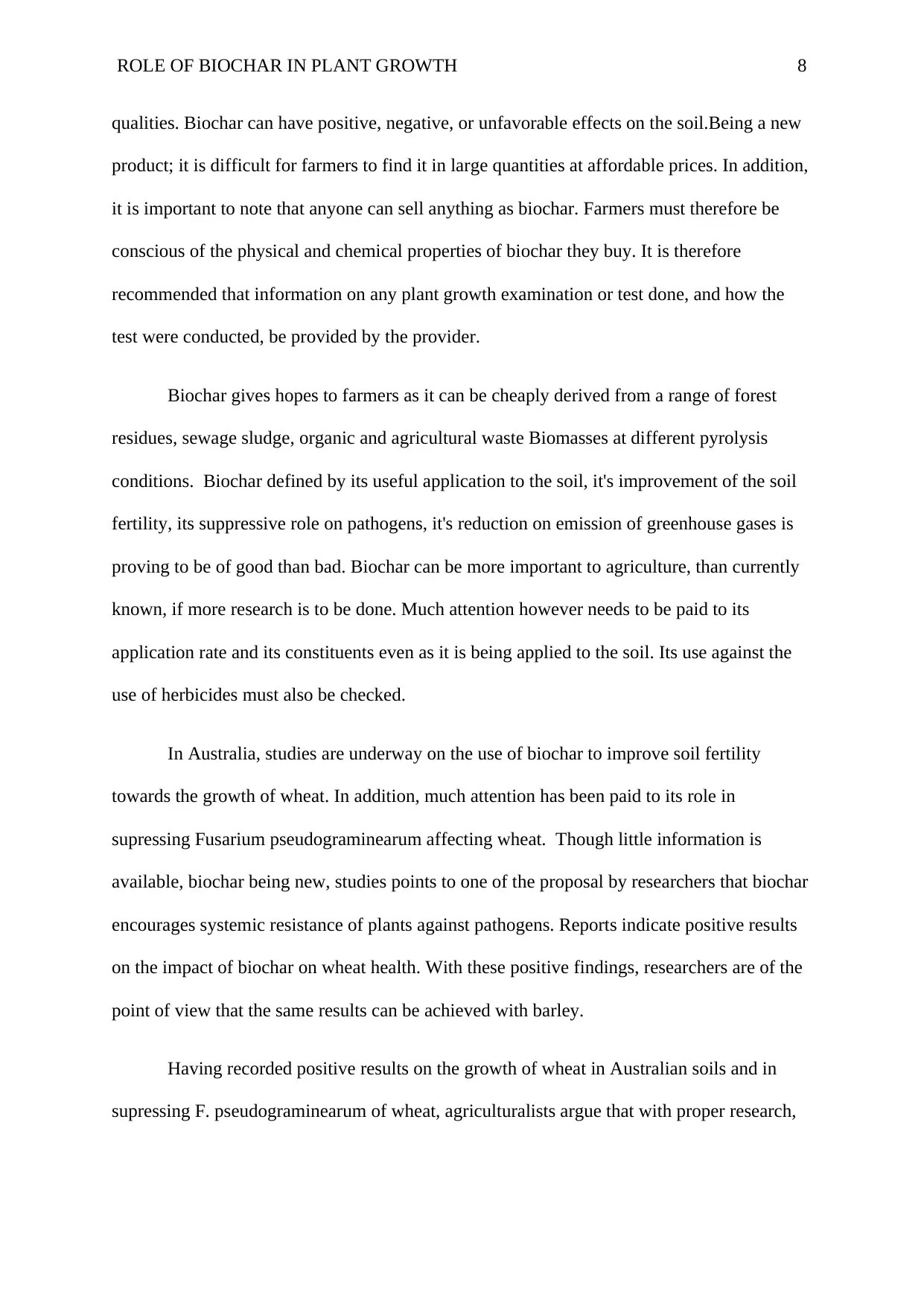
ROLE OF BIOCHAR IN PLANT GROWTH 8
qualities. Biochar can have positive, negative, or unfavorable effects on the soil.Being a new
product; it is difficult for farmers to find it in large quantities at affordable prices. In addition,
it is important to note that anyone can sell anything as biochar. Farmers must therefore be
conscious of the physical and chemical properties of biochar they buy. It is therefore
recommended that information on any plant growth examination or test done, and how the
test were conducted, be provided by the provider.
Biochar gives hopes to farmers as it can be cheaply derived from a range of forest
residues, sewage sludge, organic and agricultural waste Biomasses at different pyrolysis
conditions. Biochar defined by its useful application to the soil, it's improvement of the soil
fertility, its suppressive role on pathogens, it's reduction on emission of greenhouse gases is
proving to be of good than bad. Biochar can be more important to agriculture, than currently
known, if more research is to be done. Much attention however needs to be paid to its
application rate and its constituents even as it is being applied to the soil. Its use against the
use of herbicides must also be checked.
In Australia, studies are underway on the use of biochar to improve soil fertility
towards the growth of wheat. In addition, much attention has been paid to its role in
supressing Fusarium pseudograminearum affecting wheat. Though little information is
available, biochar being new, studies points to one of the proposal by researchers that biochar
encourages systemic resistance of plants against pathogens. Reports indicate positive results
on the impact of biochar on wheat health. With these positive findings, researchers are of the
point of view that the same results can be achieved with barley.
Having recorded positive results on the growth of wheat in Australian soils and in
supressing F. pseudograminearum of wheat, agriculturalists argue that with proper research,
qualities. Biochar can have positive, negative, or unfavorable effects on the soil.Being a new
product; it is difficult for farmers to find it in large quantities at affordable prices. In addition,
it is important to note that anyone can sell anything as biochar. Farmers must therefore be
conscious of the physical and chemical properties of biochar they buy. It is therefore
recommended that information on any plant growth examination or test done, and how the
test were conducted, be provided by the provider.
Biochar gives hopes to farmers as it can be cheaply derived from a range of forest
residues, sewage sludge, organic and agricultural waste Biomasses at different pyrolysis
conditions. Biochar defined by its useful application to the soil, it's improvement of the soil
fertility, its suppressive role on pathogens, it's reduction on emission of greenhouse gases is
proving to be of good than bad. Biochar can be more important to agriculture, than currently
known, if more research is to be done. Much attention however needs to be paid to its
application rate and its constituents even as it is being applied to the soil. Its use against the
use of herbicides must also be checked.
In Australia, studies are underway on the use of biochar to improve soil fertility
towards the growth of wheat. In addition, much attention has been paid to its role in
supressing Fusarium pseudograminearum affecting wheat. Though little information is
available, biochar being new, studies points to one of the proposal by researchers that biochar
encourages systemic resistance of plants against pathogens. Reports indicate positive results
on the impact of biochar on wheat health. With these positive findings, researchers are of the
point of view that the same results can be achieved with barley.
Having recorded positive results on the growth of wheat in Australian soils and in
supressing F. pseudograminearum of wheat, agriculturalists argue that with proper research,
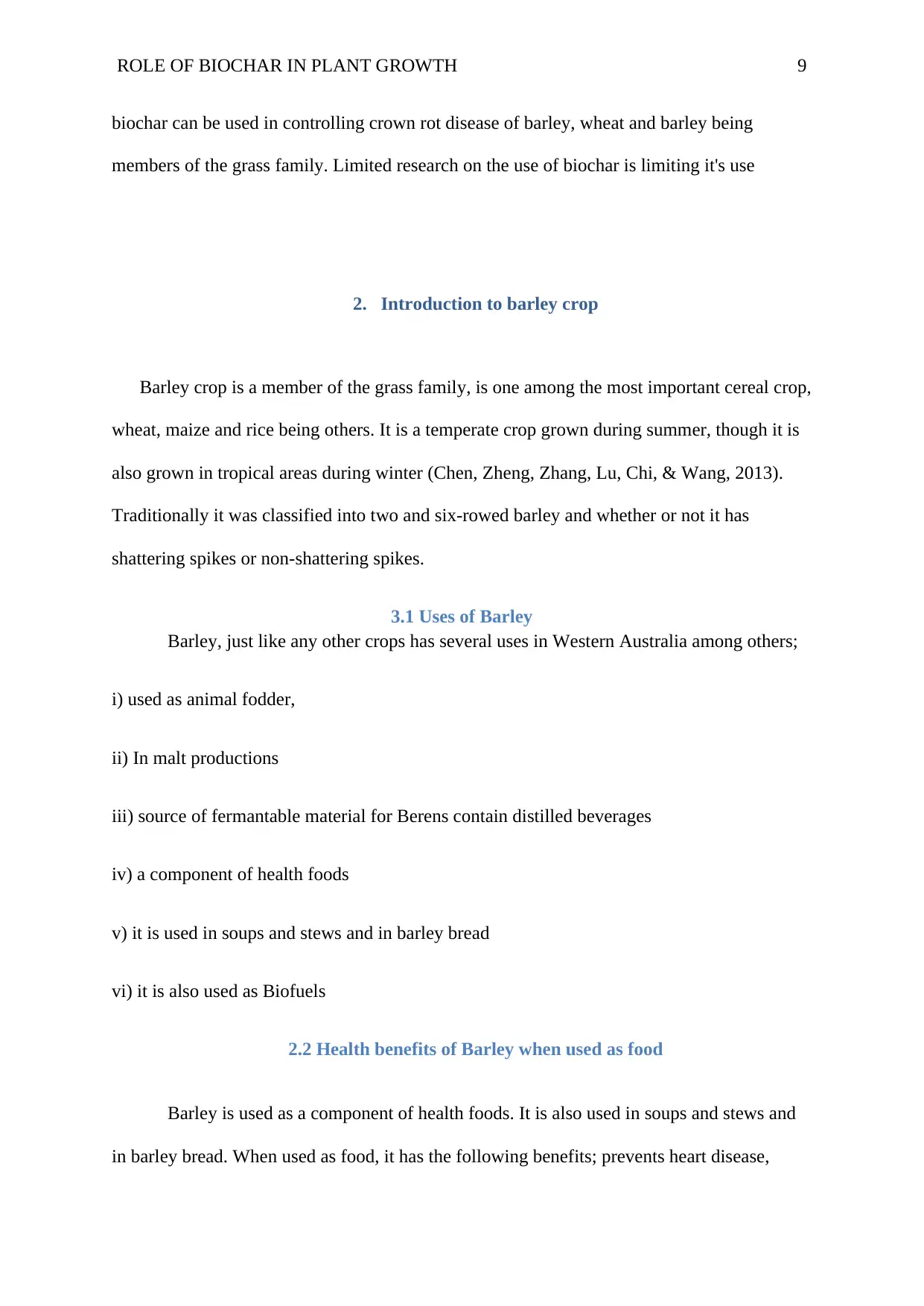
ROLE OF BIOCHAR IN PLANT GROWTH 9
biochar can be used in controlling crown rot disease of barley, wheat and barley being
members of the grass family. Limited research on the use of biochar is limiting it's use
2. Introduction to barley crop
Barley crop is a member of the grass family, is one among the most important cereal crop,
wheat, maize and rice being others. It is a temperate crop grown during summer, though it is
also grown in tropical areas during winter (Chen, Zheng, Zhang, Lu, Chi, & Wang, 2013).
Traditionally it was classified into two and six-rowed barley and whether or not it has
shattering spikes or non-shattering spikes.
3.1 Uses of Barley
Barley, just like any other crops has several uses in Western Australia among others;
i) used as animal fodder,
ii) In malt productions
iii) source of fermantable material for Berens contain distilled beverages
iv) a component of health foods
v) it is used in soups and stews and in barley bread
vi) it is also used as Biofuels
2.2 Health benefits of Barley when used as food
Barley is used as a component of health foods. It is also used in soups and stews and
in barley bread. When used as food, it has the following benefits; prevents heart disease,
biochar can be used in controlling crown rot disease of barley, wheat and barley being
members of the grass family. Limited research on the use of biochar is limiting it's use
2. Introduction to barley crop
Barley crop is a member of the grass family, is one among the most important cereal crop,
wheat, maize and rice being others. It is a temperate crop grown during summer, though it is
also grown in tropical areas during winter (Chen, Zheng, Zhang, Lu, Chi, & Wang, 2013).
Traditionally it was classified into two and six-rowed barley and whether or not it has
shattering spikes or non-shattering spikes.
3.1 Uses of Barley
Barley, just like any other crops has several uses in Western Australia among others;
i) used as animal fodder,
ii) In malt productions
iii) source of fermantable material for Berens contain distilled beverages
iv) a component of health foods
v) it is used in soups and stews and in barley bread
vi) it is also used as Biofuels
2.2 Health benefits of Barley when used as food
Barley is used as a component of health foods. It is also used in soups and stews and
in barley bread. When used as food, it has the following benefits; prevents heart disease,
⊘ This is a preview!⊘
Do you want full access?
Subscribe today to unlock all pages.

Trusted by 1+ million students worldwide
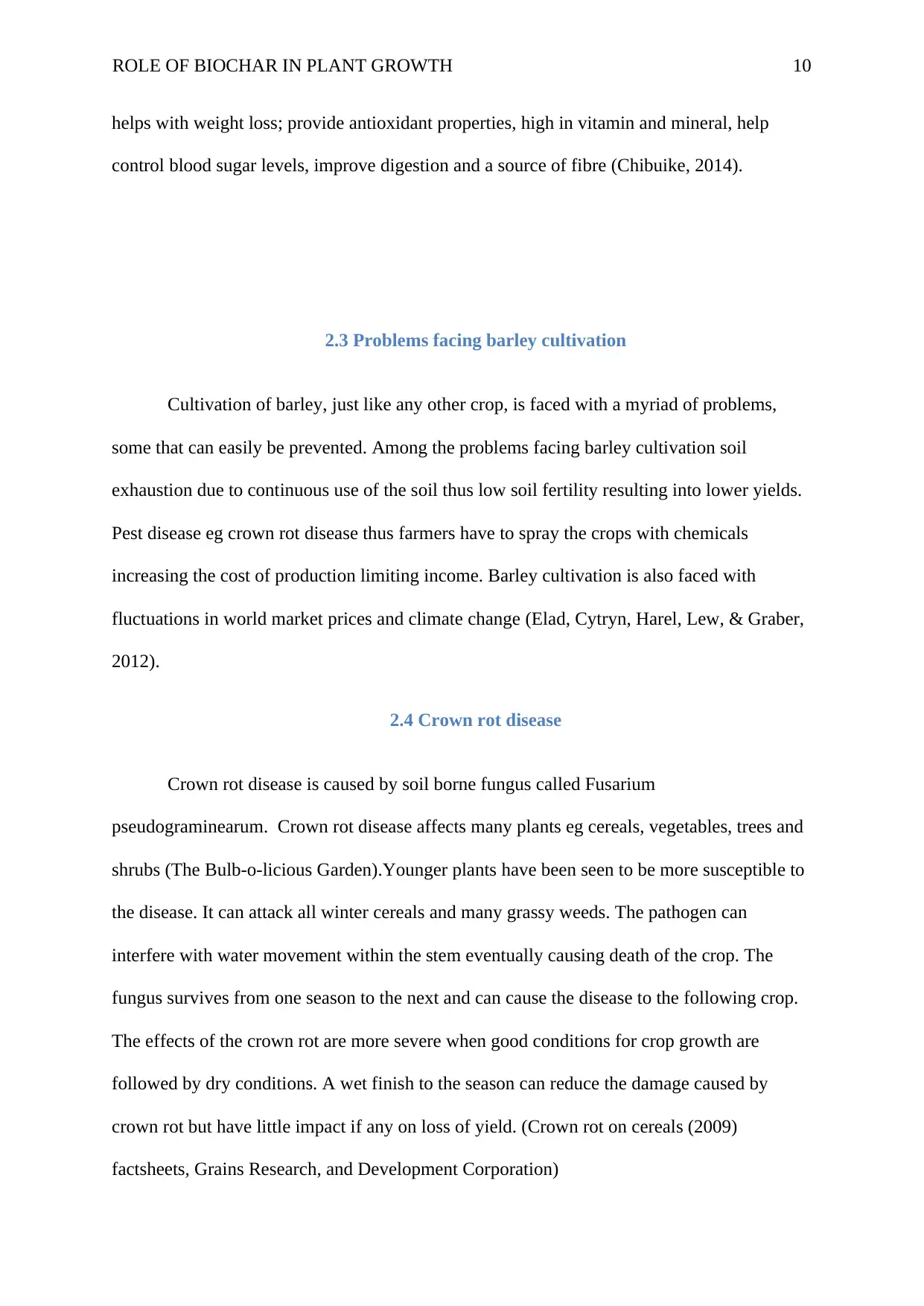
ROLE OF BIOCHAR IN PLANT GROWTH 10
helps with weight loss; provide antioxidant properties, high in vitamin and mineral, help
control blood sugar levels, improve digestion and a source of fibre (Chibuike, 2014).
2.3 Problems facing barley cultivation
Cultivation of barley, just like any other crop, is faced with a myriad of problems,
some that can easily be prevented. Among the problems facing barley cultivation soil
exhaustion due to continuous use of the soil thus low soil fertility resulting into lower yields.
Pest disease eg crown rot disease thus farmers have to spray the crops with chemicals
increasing the cost of production limiting income. Barley cultivation is also faced with
fluctuations in world market prices and climate change (Elad, Cytryn, Harel, Lew, & Graber,
2012).
2.4 Crown rot disease
Crown rot disease is caused by soil borne fungus called Fusarium
pseudograminearum. Crown rot disease affects many plants eg cereals, vegetables, trees and
shrubs (The Bulb-o-licious Garden).Younger plants have been seen to be more susceptible to
the disease. It can attack all winter cereals and many grassy weeds. The pathogen can
interfere with water movement within the stem eventually causing death of the crop. The
fungus survives from one season to the next and can cause the disease to the following crop.
The effects of the crown rot are more severe when good conditions for crop growth are
followed by dry conditions. A wet finish to the season can reduce the damage caused by
crown rot but have little impact if any on loss of yield. (Crown rot on cereals (2009)
factsheets, Grains Research, and Development Corporation)
helps with weight loss; provide antioxidant properties, high in vitamin and mineral, help
control blood sugar levels, improve digestion and a source of fibre (Chibuike, 2014).
2.3 Problems facing barley cultivation
Cultivation of barley, just like any other crop, is faced with a myriad of problems,
some that can easily be prevented. Among the problems facing barley cultivation soil
exhaustion due to continuous use of the soil thus low soil fertility resulting into lower yields.
Pest disease eg crown rot disease thus farmers have to spray the crops with chemicals
increasing the cost of production limiting income. Barley cultivation is also faced with
fluctuations in world market prices and climate change (Elad, Cytryn, Harel, Lew, & Graber,
2012).
2.4 Crown rot disease
Crown rot disease is caused by soil borne fungus called Fusarium
pseudograminearum. Crown rot disease affects many plants eg cereals, vegetables, trees and
shrubs (The Bulb-o-licious Garden).Younger plants have been seen to be more susceptible to
the disease. It can attack all winter cereals and many grassy weeds. The pathogen can
interfere with water movement within the stem eventually causing death of the crop. The
fungus survives from one season to the next and can cause the disease to the following crop.
The effects of the crown rot are more severe when good conditions for crop growth are
followed by dry conditions. A wet finish to the season can reduce the damage caused by
crown rot but have little impact if any on loss of yield. (Crown rot on cereals (2009)
factsheets, Grains Research, and Development Corporation)
Paraphrase This Document
Need a fresh take? Get an instant paraphrase of this document with our AI Paraphraser
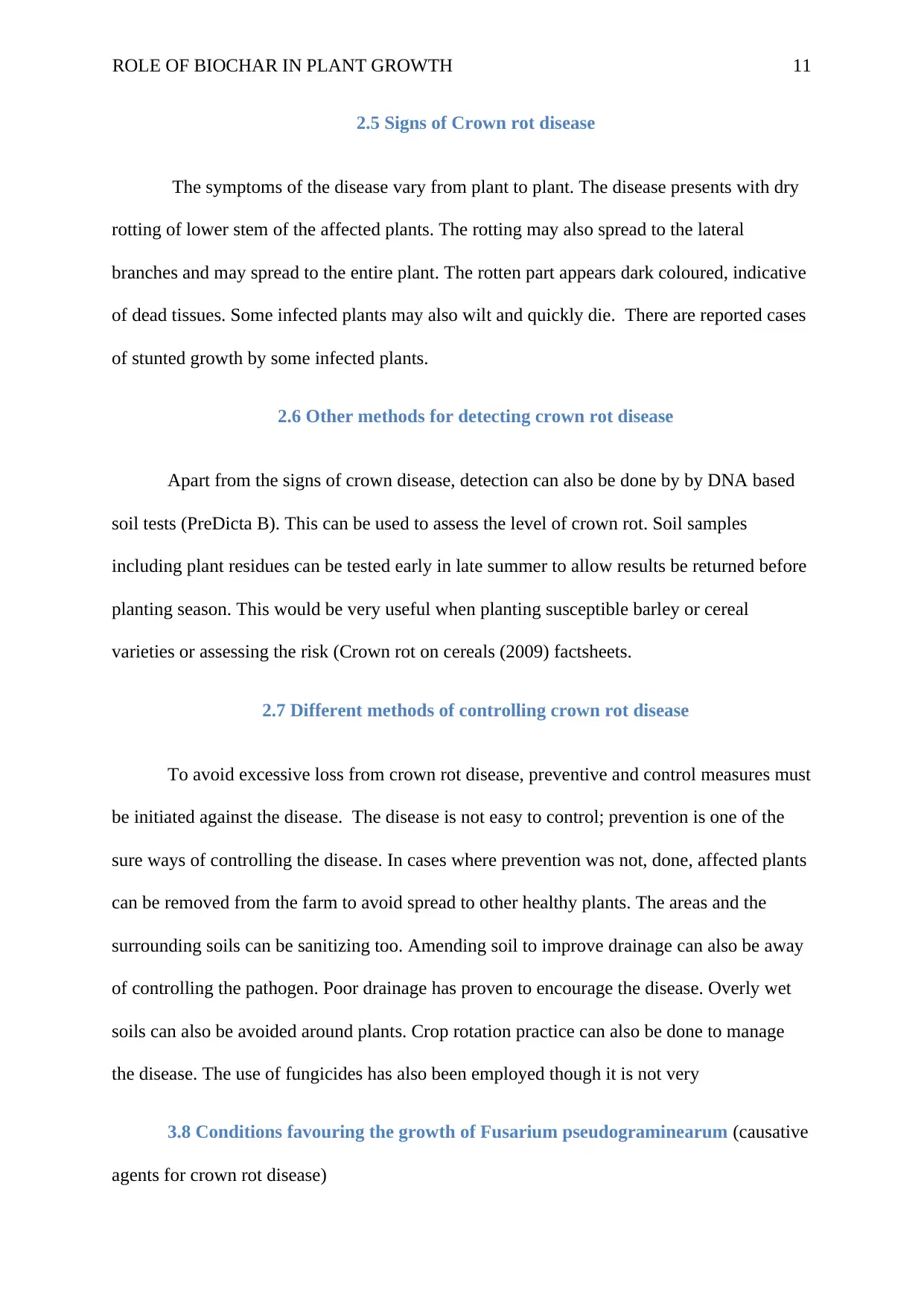
ROLE OF BIOCHAR IN PLANT GROWTH 11
2.5 Signs of Crown rot disease
The symptoms of the disease vary from plant to plant. The disease presents with dry
rotting of lower stem of the affected plants. The rotting may also spread to the lateral
branches and may spread to the entire plant. The rotten part appears dark coloured, indicative
of dead tissues. Some infected plants may also wilt and quickly die. There are reported cases
of stunted growth by some infected plants.
2.6 Other methods for detecting crown rot disease
Apart from the signs of crown disease, detection can also be done by by DNA based
soil tests (PreDicta B). This can be used to assess the level of crown rot. Soil samples
including plant residues can be tested early in late summer to allow results be returned before
planting season. This would be very useful when planting susceptible barley or cereal
varieties or assessing the risk (Crown rot on cereals (2009) factsheets.
2.7 Different methods of controlling crown rot disease
To avoid excessive loss from crown rot disease, preventive and control measures must
be initiated against the disease. The disease is not easy to control; prevention is one of the
sure ways of controlling the disease. In cases where prevention was not, done, affected plants
can be removed from the farm to avoid spread to other healthy plants. The areas and the
surrounding soils can be sanitizing too. Amending soil to improve drainage can also be away
of controlling the pathogen. Poor drainage has proven to encourage the disease. Overly wet
soils can also be avoided around plants. Crop rotation practice can also be done to manage
the disease. The use of fungicides has also been employed though it is not very
3.8 Conditions favouring the growth of Fusarium pseudograminearum (causative
agents for crown rot disease)
2.5 Signs of Crown rot disease
The symptoms of the disease vary from plant to plant. The disease presents with dry
rotting of lower stem of the affected plants. The rotting may also spread to the lateral
branches and may spread to the entire plant. The rotten part appears dark coloured, indicative
of dead tissues. Some infected plants may also wilt and quickly die. There are reported cases
of stunted growth by some infected plants.
2.6 Other methods for detecting crown rot disease
Apart from the signs of crown disease, detection can also be done by by DNA based
soil tests (PreDicta B). This can be used to assess the level of crown rot. Soil samples
including plant residues can be tested early in late summer to allow results be returned before
planting season. This would be very useful when planting susceptible barley or cereal
varieties or assessing the risk (Crown rot on cereals (2009) factsheets.
2.7 Different methods of controlling crown rot disease
To avoid excessive loss from crown rot disease, preventive and control measures must
be initiated against the disease. The disease is not easy to control; prevention is one of the
sure ways of controlling the disease. In cases where prevention was not, done, affected plants
can be removed from the farm to avoid spread to other healthy plants. The areas and the
surrounding soils can be sanitizing too. Amending soil to improve drainage can also be away
of controlling the pathogen. Poor drainage has proven to encourage the disease. Overly wet
soils can also be avoided around plants. Crop rotation practice can also be done to manage
the disease. The use of fungicides has also been employed though it is not very
3.8 Conditions favouring the growth of Fusarium pseudograminearum (causative
agents for crown rot disease)
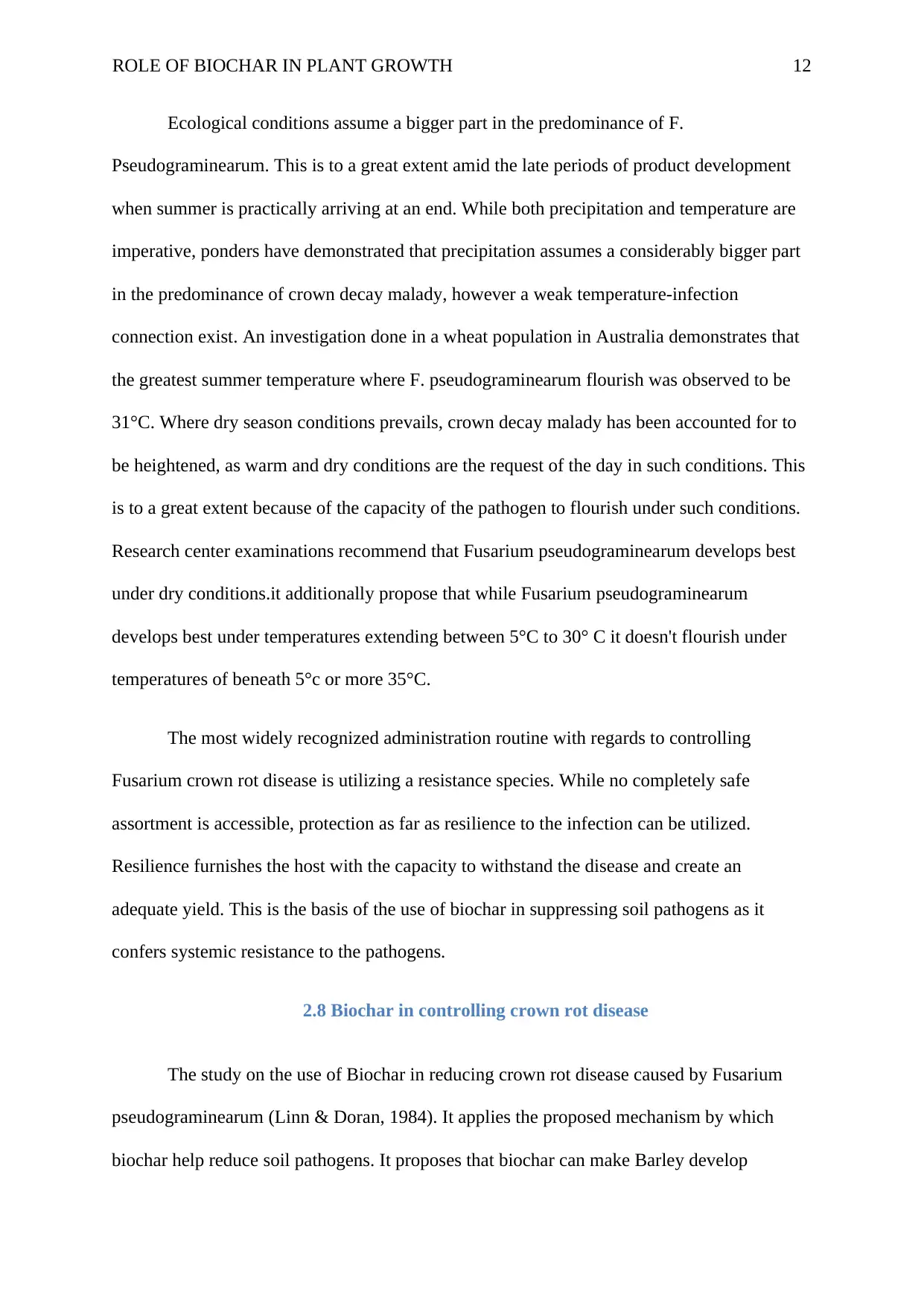
ROLE OF BIOCHAR IN PLANT GROWTH 12
Ecological conditions assume a bigger part in the predominance of F.
Pseudograminearum. This is to a great extent amid the late periods of product development
when summer is practically arriving at an end. While both precipitation and temperature are
imperative, ponders have demonstrated that precipitation assumes a considerably bigger part
in the predominance of crown decay malady, however a weak temperature-infection
connection exist. An investigation done in a wheat population in Australia demonstrates that
the greatest summer temperature where F. pseudograminearum flourish was observed to be
31°C. Where dry season conditions prevails, crown decay malady has been accounted for to
be heightened, as warm and dry conditions are the request of the day in such conditions. This
is to a great extent because of the capacity of the pathogen to flourish under such conditions.
Research center examinations recommend that Fusarium pseudograminearum develops best
under dry conditions.it additionally propose that while Fusarium pseudograminearum
develops best under temperatures extending between 5°C to 30° C it doesn't flourish under
temperatures of beneath 5°c or more 35°C.
The most widely recognized administration routine with regards to controlling
Fusarium crown rot disease is utilizing a resistance species. While no completely safe
assortment is accessible, protection as far as resilience to the infection can be utilized.
Resilience furnishes the host with the capacity to withstand the disease and create an
adequate yield. This is the basis of the use of biochar in suppressing soil pathogens as it
confers systemic resistance to the pathogens.
2.8 Biochar in controlling crown rot disease
The study on the use of Biochar in reducing crown rot disease caused by Fusarium
pseudograminearum (Linn & Doran, 1984). It applies the proposed mechanism by which
biochar help reduce soil pathogens. It proposes that biochar can make Barley develop
Ecological conditions assume a bigger part in the predominance of F.
Pseudograminearum. This is to a great extent amid the late periods of product development
when summer is practically arriving at an end. While both precipitation and temperature are
imperative, ponders have demonstrated that precipitation assumes a considerably bigger part
in the predominance of crown decay malady, however a weak temperature-infection
connection exist. An investigation done in a wheat population in Australia demonstrates that
the greatest summer temperature where F. pseudograminearum flourish was observed to be
31°C. Where dry season conditions prevails, crown decay malady has been accounted for to
be heightened, as warm and dry conditions are the request of the day in such conditions. This
is to a great extent because of the capacity of the pathogen to flourish under such conditions.
Research center examinations recommend that Fusarium pseudograminearum develops best
under dry conditions.it additionally propose that while Fusarium pseudograminearum
develops best under temperatures extending between 5°C to 30° C it doesn't flourish under
temperatures of beneath 5°c or more 35°C.
The most widely recognized administration routine with regards to controlling
Fusarium crown rot disease is utilizing a resistance species. While no completely safe
assortment is accessible, protection as far as resilience to the infection can be utilized.
Resilience furnishes the host with the capacity to withstand the disease and create an
adequate yield. This is the basis of the use of biochar in suppressing soil pathogens as it
confers systemic resistance to the pathogens.
2.8 Biochar in controlling crown rot disease
The study on the use of Biochar in reducing crown rot disease caused by Fusarium
pseudograminearum (Linn & Doran, 1984). It applies the proposed mechanism by which
biochar help reduce soil pathogens. It proposes that biochar can make Barley develop
⊘ This is a preview!⊘
Do you want full access?
Subscribe today to unlock all pages.

Trusted by 1+ million students worldwide
1 out of 19
Related Documents
Your All-in-One AI-Powered Toolkit for Academic Success.
+13062052269
info@desklib.com
Available 24*7 on WhatsApp / Email
![[object Object]](/_next/static/media/star-bottom.7253800d.svg)
Unlock your academic potential
Copyright © 2020–2025 A2Z Services. All Rights Reserved. Developed and managed by ZUCOL.





